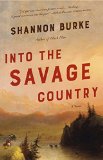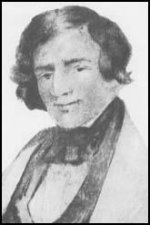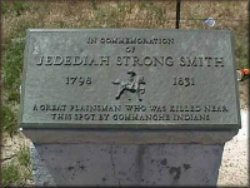Summary | Excerpt | Reviews | Beyond the Book | Read-Alikes | Genres & Themes | Author Bio

Critics' Opinion:
Readers' Opinion:
First Published:
Feb 2015, 272 pages
Paperback:
Feb 2016, 272 pages
 Book Reviewed by:
Book Reviewed by:
Kim Kovacs
Buy This Book
This article relates to Into the Savage Country
Author Shannon Burke bases many of his characters and events in Into the Savage Country on the lives and adventures of real-life American frontiersmen and trappers, the most famous of whom is Jedediah Strong Smith.
 Smith was born on January 6, 1798 in Jericho, New York (now known as Bainbridge). The fourth of 12 children, he grew up hunting and trapping. His family relocated to Pennsylvania when he was 12, and moved from there to Northern Ohio sometime later. In addition to honing his outdoors skills, Smith learned to read and write.
Smith was born on January 6, 1798 in Jericho, New York (now known as Bainbridge). The fourth of 12 children, he grew up hunting and trapping. His family relocated to Pennsylvania when he was 12, and moved from there to Northern Ohio sometime later. In addition to honing his outdoors skills, Smith learned to read and write.
He moved to Illinois around 1820 to practice farming, but apparently the life was too tame for him. He saw a newspaper ad posted by William Ashley, who was hiring 100 men to trap beaver along the Missouri River. He joined the expedition in 1822 on what became a difficult journey up the river to their eventual camp – a small fort on the Yellowstone River dubbed Fort Henry. Over the course of the trip their first boat sank, putting them behind schedule. The men had to drag the replacement up the river using ropes (although Smith often escaped this task, as his hunting forays are what fed the company).
Over the course of the winter the trappers encountered many serious obstacles, including the loss of supplies and horses during conflicts with Native American tribes. Smith became known as a person of stature who could be relied upon to keep his head in a crisis, and when Ashley returned to St. Louis for supplies, he left Smith as captain of the group. Under Ashley's orders, Smith led the fur trappers deeper into the Rocky Mountains on what became a very profitable expedition.
In 1823 Smith set out with a small band of mountain men to explore the Black Hills of Dakota and was mauled by a grizzly bear during the journey. The bear ripped open his side and broke several ribs, gashed his head and tore away most of one ear. The men sewed up Smith's wounds as best they could (and remarkably he was well enough to trap 10 days later), but his face and head were permanently scarred.
The men continued west to Dubois, Wyoming, where they camped for the winter. They learned from a friendly band of Crow Indians that there was an easier way across the Rockies than their planned route. Relying on the tip, the following spring, Smith led his party over the range through what became known as the South Pass. Although this was technically a rediscovery – Astor's Pacific Fur Company crossed the pass in 1812 – Smith was the first to publish it and so is credited with the find. It was much safer than the commonly used Missouri River path opened by Lewis and Clark in 1804 and it consequently became the primary route for settlers moving west to Oregon and California.
Smith set out on his final fur-trapping expedition in 1826, a sojourn that lasted two years, during which time he explored important landmarks such as the Great Salt Lake and The Colorado Plateau, and he led the first known overland expedition into Southwest California. Most of his companions died over the period, killed by hunger, thirst, cold, and hostile Native Americans. Only four of the 17 men who set out survived the ordeal - and they only lived because of help provided by British fur traders (their competition). All told, Smith traveled twice the distance of the Lewis and Clark expedition, and covered a broader expanse of territory.
 Returning to St. Louis in 1830, Smith decided to retire from trapping to enter a mercantile business with his brothers. He believed that most of the West had been trapped out, and the large and profitable early hauls created additional competition for the limited resources as more men sought to get rich through trapping. In addition, lack of animal pelts pushed trappers more and more into hostile Blackfoot territory, creating far too much risk for the amount of return Smith believed he'd be able to get. In support of the business, he was leading a trading caravan along the Santa Fe Trail when conditions forced him to leave the group to scout for water. It is believed that he was killed by Comanche Indians on May 27, 1831 near the Cimarron River.
Returning to St. Louis in 1830, Smith decided to retire from trapping to enter a mercantile business with his brothers. He believed that most of the West had been trapped out, and the large and profitable early hauls created additional competition for the limited resources as more men sought to get rich through trapping. In addition, lack of animal pelts pushed trappers more and more into hostile Blackfoot territory, creating far too much risk for the amount of return Smith believed he'd be able to get. In support of the business, he was leading a trading caravan along the Santa Fe Trail when conditions forced him to leave the group to scout for water. It is believed that he was killed by Comanche Indians on May 27, 1831 near the Cimarron River.
Picture of Jedediah Strong Smith from Spartacus Educational
Picture of marker from Santa Fe Trail Research
Filed under People, Eras & Events
![]() This "beyond the book article" relates to Into the Savage Country. It originally ran in March 2015 and has been updated for the
February 2016 paperback edition.
Go to magazine.
This "beyond the book article" relates to Into the Savage Country. It originally ran in March 2015 and has been updated for the
February 2016 paperback edition.
Go to magazine.





The Funeral Cryer by Wenyan Lu
Debut novelist Wenyan Lu brings us this witty yet profound story about one woman's midlife reawakening in contemporary rural China.
Your guide toexceptional books
BookBrowse seeks out and recommends the best in contemporary fiction and nonfiction—books that not only engage and entertain but also deepen our understanding of ourselves and the world around us.